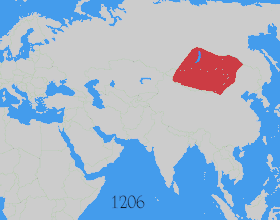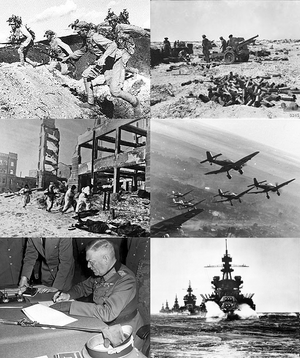A Brief History
On May 8, 1945, Nazi Germany surrendered unconditionally to the allies and ceased to exist as a state. You may count Germany invading Poland in 1939 as the start of World War II (also known as The Second World War) or the Japanese invasion of Manchuria in 1937, but in any case most people would guess correctly that World War II cost more lives than any other war in history. (Please note that total lives lost in each war are also debatable, and the list can be rearranged somewhat depending on your analysis of the sources.) The rest of the list of the 10 Deadliest Wars may surprise some of you. We do predict you will wonder how there can be so many Chinese people today since so many have been killed in wars.
Digging Deeper
10. Tamerlane’s Conquests, 1370-1405 (between 7 and 20 million dead)
Tamerlane (multiple versions of the spelling of his name, too many to list here) was a Turko-Mongol leader that terrorized Central Asia, North Africa, The Middle East and Eastern Europe with his “Sword of Islam.” His multinational forces defeated Muslim Egypt and Syria, the Ottomans (Turkey), Iran, and the Sultanate of Dehli (India). Of course, he was brutally successful against Christian armies as well, conquering Armenia and Georgia. He sought to reestablish the Mongol Empire. Tamerlane came from the region that today is Uzbekistan. An opportunist, Tamerlane used Mongol heritage to his advantage as well as using Islam when it suited him. His own religious views are unclear. Tamerlane also attempted to take over China with the help of Mongol allies but died before he could achieve that.
9. Dungan Revolt, 1862-1877 (between 8 to 12 million dead)
A revolt by the Muslim Hui in China (sometimes called the Hui Minorities War) that more resembled the world’s largest riot than an organized war. Starting over the sale of bamboo poles, various factions of Muslims in western China fought every form of authority as well as each other, finally creating a mass exodus to Kyrgyzstan, Kazakhstan, and Russia. (Note: The Dugan or Hui are not the Uyghur Chinese Muslims we hear about today. They are a separate people.)
8. Red Eyebrows Rebellion (China), 9-24 (10 million deaths)
More properly known as (the not as cool sounding) Chimei Rebellion, peasant farmers rebelled against the Xin Dynasty, weakening it to the point where it easily fell. Floods and incompetent government pushed the peasants to the point of starvation, forcing the rebellion.
7. Era of Warring States (China), 475-221 BC (10 million deaths)
A period of 250 years in ancient China when there was no China, just several large areas that fought more or less constantly until the Qin State won over the others and established the Qin Dynasty over an area almost as big as modern China. The actual detailed account of these battles is convoluted enough that unless you are a hard corps historian you could easily get overwhelmed by all the facts and factions. To think of this many people killed with the technology (or lack thereof) that long ago is sobering.
6. An Lushan Rebellion (China), 755-763 (13 million deaths)

Named for General An Lushan, this rebellion in northern China attempted to overthrow the Tang Dynasty and establish a new Yan Dynasty. Also known as the An-Shi Rebellion, it failed to topple the Tang Dynasty but did weaken it, causing the loss of some of the western Chinese territory to the Tibetan Empire.
5. World War I, 1914-1918 (between 16 and 40 million deaths)

Known as The Great War or The World War until World War II, this war was also fought all over the globe, although the grand scale of the war was fought in Europe and the Middle East. Featuring extensive use of machine guns, motorized vehicles (including the first tanks), aircraft, submarines and poison gas, this war was truly the first of the “modern” wars. Although sometimes called The War to End All Wars, World War I actually did not solve the world’s problems and set the stage for World War II, which can be seen as Part 2 of a two part world war. This war saw the end of the Austro-Hungarian Empire and the end of Imperial Russia, giving birth to the Soviet Union. It also made the United States a considerable world power.
4. Taiping Rebellion (China), 1850-1864 (20 million dead)

A rebellion against the ruling Qing Dynasty by southern Chinese using Nanjing as their capital and calling themselves Taiping Heavenly Kingdom. A key aspect of the rebellion was to reject eastern religions (Confucianism, Buddhism, and local traditional sects) and replace them with Christianity. An interesting note is that both Sun Yat-sen (who founded Nationalist China in 1912) and Mao Zedong (aka Mao Tse-tung, leader of the communist revolution that took over in 1949) glorified the Taiping rebels.
3. (China), 1616-1662 (about 25 million killed)
The exact date to use as the ending of the war is not so clear, but the vast amount of people killed is. The Qing (pronounced Ching for some reason in spite of the “Q”) Dynasty finds its origins in Manchuria, which set out to conquer the rest of China and in so doing usurped the Ming Dynasty. The Qing Dynasty was the last of the Imperial Chinese dynasties and lasted until 1912.
2. Mongol Conquests, 1206-1324 (between 30 and 60 million deaths)

During this time period the Mongols spread out from Mongolia west to cover Russia and Eastern Europe, south to China, Korea, and India, and southwest to the middle east. For almost the entire time fighting took place, alternately of conquest and of liberation, eventually the vast empire shrunk from the largest in history to just a moderate size. Mongol influence remained in India for centuries beyond.
1. World War II, 1937 (or 1939) to 1945 (between 60 and over 80 million people killed)
Truly a global war, fought all over the world from the tropics to the arctic and ending in the only use of nuclear weapons in history. Technology advanced incredibly fast during the war, with widespread use of Radar, Sonar, electronic guidance for airplanes, electronic jamming of radio and other signals, jet aircraft, cruise missiles, guided bombs, rockets that could attack from 200 miles away, and the first assault rifles. The first computer was built for the purpose of decoding enemy communications. (Note: For our purposes we do not list the Second Sino-Japanese War separately.) Once again, depending on what method you calculate by countries, between 30 and over 40 nations were at war. Some nations had their own civil wars going on at the same time. Major neutral nations were Switzerland, Spain and Sweden. The end of World War II left only the US and the USSR as major world powers.
Question for students (and subscribers): Do you think a future war will surpass the death tolls of these wars? Please let us know in the comments section below this article.
If you liked this article and would like to receive notification of new articles, please feel welcome to subscribe to History and Headlines by liking us on Facebook and becoming one of our patrons!
Your readership is much appreciated!
Historical Evidence
For more information, please see…
Hunt, Robert and Martin W. Sandler. What Was America’s Deadliest War?: And Other Questions About The Civil War (Good Question!). Sterling Children’s Books, 2014.
Michno, Gregory. Deadliest Indian War in the West. Caxton Press, 2007.
Rawlence, Ben. Radio Congo: Signals of Hope from Africa’s Deadliest War. Oneworld Publications, 2013.
Thomas, Mark. The Deadliest War (Townsend Library). Townsend Press, 2011.
The featured image in this article, the Instrument of Surrender document, is a work of an employee of the United States Farm Security Administration or Office of War Information domestic photographic units, taken as part of that person’s official duties. As a work of the U.S. federal government, the image is in the public domain in the United States. See Copyright.



